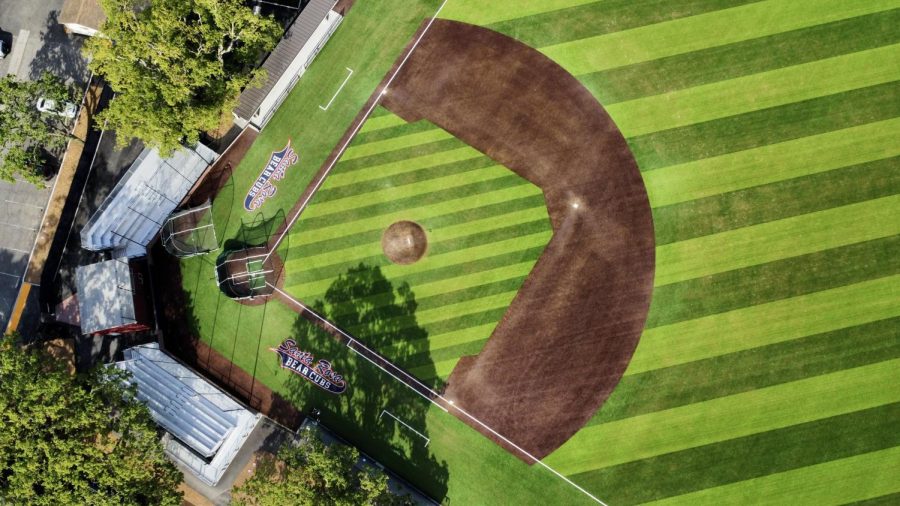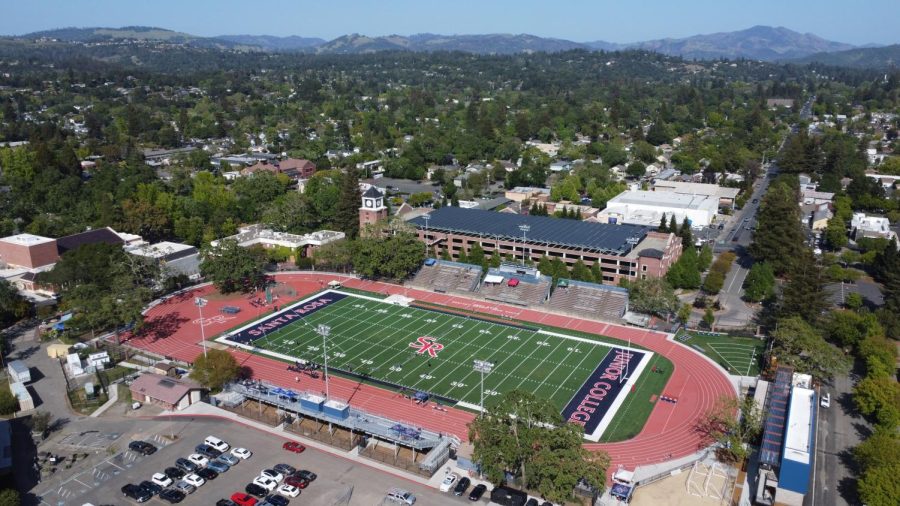Santa Rosa Junior College may not offer Division I athletics, but you wouldn’t know it from the looks of campus’ south side, where approximately $31.4 million in state-of-the-art construction is underway to benefit the 500-plus athletes who play on 17 teams representing the Bear Cubs.
“If you look around at all the big schools like Michigan and Alabama, they have great facilities, and they have great facilities for a reason, because it helps with recruiting, and that’s no different at our level,” said SRJC Athletic Director Matt Markovich.
New projects include a new track and field facility with a rubberized track, a new turf football field and a two-story field house at the south end of the Bailey Field complex. The field house’s first floor will house locker rooms for the football team, track and field and cross country teams. The second level will consist of coaches’ offices and a conference room.
“[Football] coach [Lenny] Wagner told me that he has not lost a recruit yet since we put these facilities in,” Markovich added when discussing the immediate impact to the football team.
Updates to the track and field facilities give SRJC the ability to host track meets. The Big Eight Conference Trials and Finals took place on campus for the first time in late April 2022.
Renovations include a new turf softball field, new bleachers, a press box and a new fence. Updates to the baseball facility include a turf field and batting cages. A Bermuda grass soccer field was added for men’s and women’s soccer to share. An Olympic-length racing pool was built for the swim and dive team.
All outdoor facilities should be completed by mid-May, Markovich said.
“We’re setting up our athletic facilities for the next generation of Sonoma County high school students,” he said.
The new facilities provide safer playing surfaces that prevent injury. For example, all of the new turf fields have a shock pad underneath, which helps absorb impact.
“The type of turf we put in is probably the safest turf we could put in,” Markovich said.
Markovich was on the committee that included coaches and faculty members who helped make decisions for the renovations.
But for women’s soccer coach Crystal Chaidez, the biggest difference is that “we’ve never had our own field for both women’s and men’s soccer. We’ve always either been on the baseball field…or been off campus at someone else’s field,” she said. “It’s gonna be a huge difference just feeling at home.”
Chaidez noted that the new field has boosted the recruitment process. “I take all of my recruits over there so they can see the field, and they’re all super excited,” she said.
Chaidez told next year’s team “they’re making history, this is the first time ever that we’re going to have our own facility, and they get to be the first group to play on it.” The new field house on Bailey Field has been planned for 15 years, since Keith Simons was the head football coach. Coach Wagner said there were even blueprints drawn up. “We designed a whole different building back in the day, and because of the amount of funding we got, it has changed over the years and morphed into what we see now,” Wagner said.
The football team won’t be scattered, according to Wagner. “Position meetings were all over campus, and it was not a central location. Now, everything’s gonna happen in there,” he said.
Wagner believes the field house will give the team a sense of ownership that’s been missing. “We’re in here all the time, you know, [an] ‘It’s our house’ type of thing.”
When designing the field house, the football staff took ideas from a plethora of other junior colleges. “We really had a good idea of what was working for coaches because we asked them questions, ‘What would you change? If you could change something, what would you do different?’” Wagner said.
Players are looking forward to the new space, too. “I am really excited to see what the new lockers have in store. I think it will be a nice change from our previous locker room that we had to share with the other sports teams,” said offensive lineman Gabe Avila.
“It’s finally come to fruition, so to see it happen is just awesome,” Wagner said.
Funding for these projects came from Measure H, which passed in 2014 and granted the college $410 million from taxpayers to be used for new math, science and laboratory spaces and the new athletics and kinesiology department facilities.
“I’m a big believer that athletics is a great vehicle to get people to graduate and go through school,” Markovich said, “and I believe that having great facilities is a big piece of that.”





